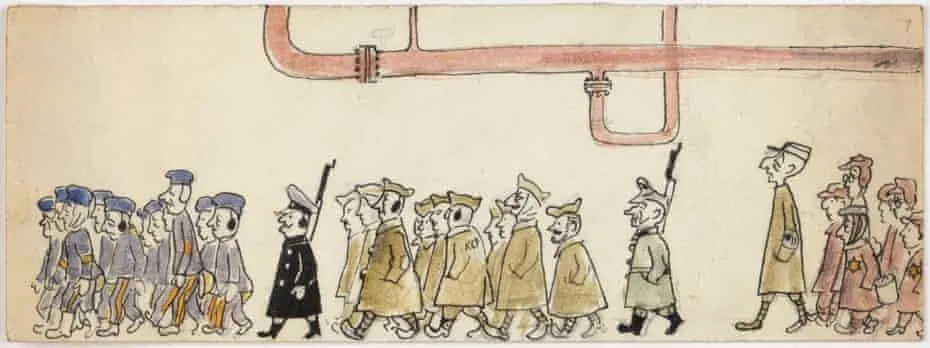Drawing on Their Escapes From the Nazis, These Artists Became Celebrated Cartoonists
A groundbreaking female comic book artist, a MAD magazine star and a counterfeiter-turned-illustrator share the floor in an exhibit in New York City
:focal(522x240:523x241)/https://tf-cmsv2-smithsonianmag-media.s3.amazonaws.com/filer/f8/c1/f8c1f777-3601-4219-ae91-02e06d640f4a/lily_renee_comic.jpg)
Cartoonists Lily Renée, Bil Spira and Paul Peter Porges have more in common than their art. All three had their world turned upside down by Nazi Germany's annexation of Austria, their home country, in 1938. The young Jewish artists survived World War II and went on to sucessful careers in cartooning, design and other artistic forms. Their work, along with other materials from their eventful lives, forms the basis for “Three with a Pen,” now on display at the Austrian Cultural Forum New York.
“When I saw this exhibit at the Jewish Museum Vienna in 2019, I thought, ‘Now, let’s bring this to New York,’” Forum director Michael Haider tells the Guardian’s Nadja Sayej.
New York is where Renée and Porges eventually made their careers after long journeys. When the Nazi persecution of Jews began in Austria, both their parents put them on Kindertransports— humanitarian rescue operations for Jewish children.
Porges, who was born in 1927, escaped to France. After Germany invaded that country, he ended up in an internment camp, but he escaped at age 16 and was eventually reunited with his parents and brother in New York. He went on to enlist in the U.S. Army, where he created a popular comic strip for Stars and Stripes. Later he drew cartoons for the New Yorker, the Saturday Evening Post and Look, among other national publications. Known as PPP, he also wrote more than 200 articles for MAD magazine between 1966 and 2009. He died in 2016.
Renée, born in 1921, traveled from Austria to England and then to New York, where she rejoined her parents. There, she began drawing comic books featuring Señorita Rio, the Nazi-fighting alter-ego of a Hollywood starlet. As Karen Chernick reports for the Jewish Telegraphic Agency, Renée also had a secret identity.
“Everybody assumed I was a man,” Renée, who signed her work “L. Renee,” tells JTA.
That’s not surprising, according to Michael Freund, co-curator of the exhibition.
“Before World War II, women comic artists were a very rare breed indeed,” he tells JTA.” “It was mostly the turf of hungry young guys.”

But, like in many industries, the men leaving the comic book world to fight in the war opened up new opportunities for women. And, with a huge market for comics among soldiers, illustrating the books was a way for Renée to make a living with her artistic skills. She worked her way up from painting backgrounds to drawing characters.
“Her breakthrough came when she embellished—in every sense of the word—the character of Señorita Rio, a spy and secret agent for the Allied forces,” exhibition co-curator Sabine Bergler tells JTA. “Rio was not invented by Lily, but she contributed to the storyline and to the specific characteristics of the heroine—who was also a projection of her own desire to fight the fascist powers.”
Renée continued her career as a freelance artist and textile designer and also wrote plays and children’s books. She’s still living in New York and will celebrate her 100th birthday in May.
At the time of the Anschluss (the annexation of Austria into Nazi Germany), Spira was already a young adult with a fast-moving career. Born in 1913, he’d begun producing work for newspapers in high school and gone on to work on an animated cartoon. After the Nazi invasion, he was arrested and ordered out of the country. He escaped to Paris, and then to Marseille, where he began forging identification papers and passports to help refugees escape occupied Europe. After an associate betrayed him, he spent the rest of the war in internment and concentration camps, where he would trade drawings for cigarettes.
“He drew in the concentration camps, but if the guards saw it, he would be executed,” Haider tells the Guardian. “He was documenting what he saw in the camp. He hid it.”
Haider adds that the Russian forces who liberated the camp burned all of the prisoners’ possessions, including Spira’s hidden drawings. However, other inmates had smuggled some of them out, and several of these appear in the exhibition.
After the war, Spira returned to France, where he worked as an illustrator. He died in 1999.
“We wanted to honor the works of art of all three artists, to show they were great artists, despite the fact that they were survivors,” Bergler tells the Guardian. “On the other hand, we wanted to show they were survivors too. We tried to show the people behind the artworks, to see them each as independent artists, and how the Holocaust was the fate of their work.”
“Three with a Pen” is on display at the Austrian Cultural Forum New York through September 3. A virtual exhibition opening and exhibition teaser are available online.
/https://tf-cmsv2-smithsonianmag-media.s3.amazonaws.com/accounts/headshot/Livia_lg_thumbnail.png)
/https://tf-cmsv2-smithsonianmag-media.s3.amazonaws.com/accounts/headshot/Livia_lg_thumbnail.png)